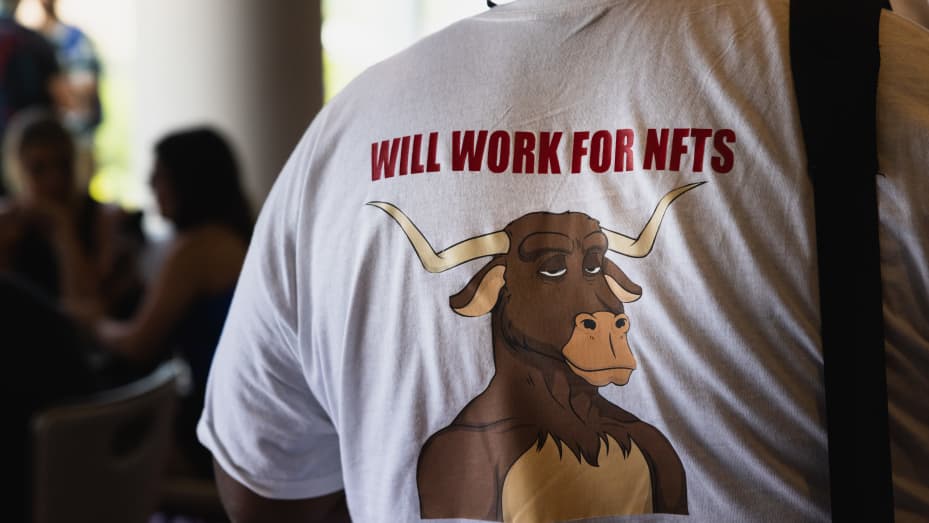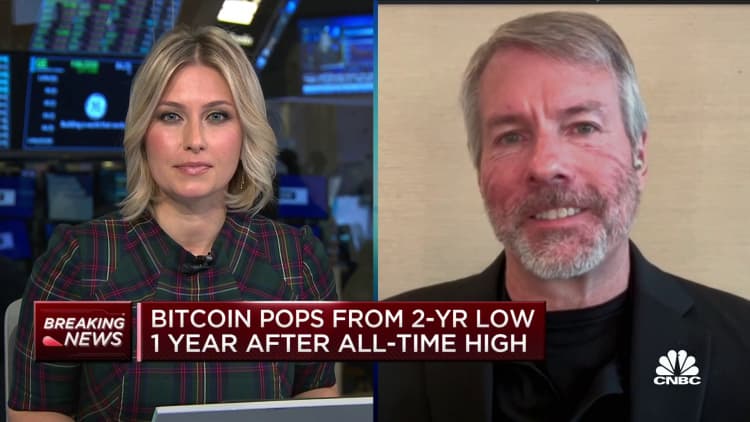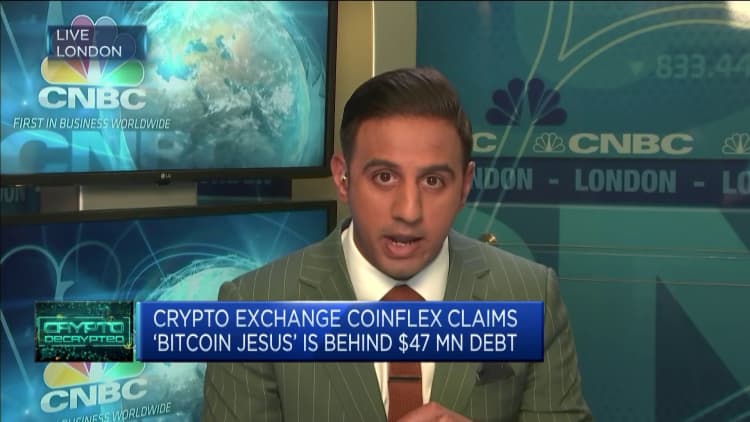Crypto peaked a year ago — investors have lost more than $2 trillion since
KEY POINTS
- A year after bitcoin peaked at more than $68,000 it’s down below $18,000.
- The industry has been hit with macroeconomic challenges, market forces and scandals.
- What was dubbed the crypto winter earlier this year turned disastrous this week with the spectacular collapse of FTX.
 An attendee wears a “Will Work for NFTs” shirt during the CoinDesk 2022 Consensus Festival in Austin, Texas, US, on Thursday, June 9, 2022. The festival showcases all sides of the blockchain, crypto, NFT, and Web 3 ecosystems, and their wide-reaching effect on commerce, culture, and communities.
An attendee wears a “Will Work for NFTs” shirt during the CoinDesk 2022 Consensus Festival in Austin, Texas, US, on Thursday, June 9, 2022. The festival showcases all sides of the blockchain, crypto, NFT, and Web 3 ecosystems, and their wide-reaching effect on commerce, culture, and communities.
Jordan Vonderhaar | Bloomberg | Getty Images
A year ago this week, investors were describing bitcoin as the future of money and ethereum as the world’s most important developer tool. Non-fungible tokens were exploding, Coinbase was trading at a record and the NBA’s Miami Heat was just into its first full season in the newly renamed FTX Arena.
As it turns out, that was peak crypto.
In the 12 months since bitcoin topped out at over $68,000, the two largest digital currencies have lost three-quarters of their value, collapsing alongside the riskiest tech stocks. The industry, once valued at roughly $3 trillion, now sits at around $900 billion.
Rather than acting as a hedge against inflation, which is near a 40-year high, bitcoin has proven to be another speculative asset that bubbles up when the evangelists are behind it and plunges when enthusiasm melts and investors get scared.
And the $135 million that FTX spent last year for a 19-year deal with the Heat? The crypto exchange with the naming rights is poised to land in the history books alongside another brand that once had its logo on a sports facility: Enron.
In a blink this week, FTX sank from a $32 billion valuation all the way to bankruptcy as liquidity dried up, customers demanded withdrawals and rival exchange Binance ripped up its nonbinding agreement to buy the company. FTX founder Sam Bankman-Fried admitted on Thursday that he “f---ed up.” On Friday, he stepped down as CEO.
“Looking back now, the excitement and prices of assets were clearly getting ahead of themselves and trading far above any fundamental value,” said Katie Talati, director of research at Arca, an investment firm focused on digital assets. “As the downturn was so fast and violent, many have proclaimed that digital assets are dead.”
Whether crypto is forever doomed or will eventually rebound, as Talati expects, the 2022 bloodbath exposed the industry’s many flaws and served as a reminder to investors and the public why financial regulation exists. Bankruptcies have come fast and furious since midyear, leaving clients with crypto accounts unable to access their funds, and in some cases scrapping to retrieve pennies on the dollar.
Read more about tech and crypto from CNBC Pro
This self-driving car technology stock could pop by more than 400%, say three analysts
Looking for alternatives to Nvidia? Futurum CEO names 3 he’s bullish on for 2024
Bernstein tech analyst’s best idea for 2024 is to short Tesla
Morgan Stanley picks ‘alpha’ opportunities in China tech - giving one 52% upside
If this is indeed the future of finance, it’s looking rather bleak.
Crypto was supposed to bring transparency. Transactions on the blockchain could all be tracked. We didn’t need centralized institutions — banks — because we had digital ledgers to serve as the single source of truth.
That narrative is gone.
“Speaking for the bitcoiners, we feel like we’re trapped in a dysfunctional relationship with crypto and we want out,” said Michael Saylor, executive chairman of MicroStrategy, a technology company that owns 130,000 bitcoins. “The industry needs to grow up and the regulators are coming into this space. The future of the industry is registered digital assets traded on regulated exchanges, where everyone has the investor protections they need.” WATCH NOW
WATCH NOW
VIDEO03:46
Bitcoin bull Michael Saylor on FTX-Binance chaos: Crypto industry needs to grow up
Saylor was speaking on CNBC’s “Squawk on the Street” as FTX’s demise roiled the crypto market. Bitcoin sank to a two-year low this week, before bouncing back on Thursday. Ethereum also tanked, and solana, another popular coin used by developers and touted by Bankman-Fried, fell by more than half.
Equities tied to crypto suffered, too. Crypto exchange Coinbase tumbled 20% over two days, while Robinhood, the trading app that counts Bankman-Fried as one of its biggest investors, fell by 30% during the same period.
There was already plenty of pain to go around. Last week, Coinbase reported a revenue plunge of more than 50% in the third quarter from a year earlier, and a loss of $545 million. In June, the crypto exchange slashed 18% of its workforce.
“We are actively updating and evaluating our scenario plans and prepared to reduce operating expenses further if market conditions worsen,” Alesia Haas, Coinbase’s finance chief, said on the Nov. 3 earnings call.
How it started
The downdraft started in late 2021. That’s when inflation rates started to spike and sparked concern that the Federal Reserve would begin hiking borrowing costs when the calendar turned. Bitcoin tumbled 19% in December, as investors rotated into assets deemed safer in a tumultuous economy.
The sell-off continued in January, with bitcoin falling 17% and ethereum plummeting 26%. David Marcus, former head of crypto at Facebook parent Meta, used a phrase that would soon enter the lexicon.
“It’s during crypto winters that the best entrepreneurs build the better companies,” Marcus wrote in a Jan. 24 tweet. “This is the time again to focus on solving real problems vs. pumping tokens.”
The crypto winter didn’t actually hit for a few months. The markets even briefly stabilized. Then, in May, stablecoins became officially unstable.
A stablecoin is a type of digital currency designed to maintain a 1-to-1 peg with the U.S. dollar, acting as a sort of bank account for the crypto economy and offering a sound store of value, as opposed to the volatility experienced in bitcoin and other digital currencies.
When TerraUSD, or UST, and its sister token called luna dove below the $1 mark, a different kind of panic set in. The peg had been broken. Confidence evaporated. More than $40 billion in wealth was wiped out in luna’s collapse. Suddenly it was as if nothing in crypto was safe.
The leading crypto currencies cratered, with bitcoin dropping 16% in a single week, putting it down by more than half from its peak six months earlier. On the macro front, inflation had shown no sign of easing, and the central bank remained committed to raising rates as much as would be required to slow the increase in consumer prices.
In June, the bottom fell out.
Lending platform Celsius paused withdrawals because of “extreme market conditions.” Binance also halted withdrawals, while crypto lender BlockFi slashed 20% of its workforce after more than quintupling since the end of 2020. WATCH NOW
WATCH NOW
VIDEO01:31
Three Arrows Capital plunges into liquidation. Here’s how it happened
Prominent crypto hedge fund Three Arrows Capital, or 3AC, defaulted on a loan worth more than $670 million, and FTX signed a deal giving it the option to buy BlockFi at a fraction of the company’s last private valuation.
Bitcoin had its worst month on record in June, losing roughly 38% of its value. Ether plummeted by more than 40%.
Then came the bankruptcies.
Singapore-based 3AC filed for bankruptcy protection in July, just months after disclosing that it had $10 billion in assets. The firm’s risky strategy involved borrowing money from across the industry and then turning around and investing that capital in other, often nascent, crypto projects.
After 3AC fell, crypto brokerage Voyager Digital wasn’t far behind. That’s because 3AC’s massive default was on a loan from Voyager.
“We strongly believe in the future of the industry but the prolonged volatility in the crypto markets, and the default of Three Arrows Capital, require us to take this decisive action,” Voyager CEO Stephen Ehrlich said at the time.
Next was Celsius, which filed for Chapter 11 protection in mid-July. The company had been paying customers interest of up to 17% to store their crypto on the platform. It would lend those assets to counterparties willing to pay sky-high rates. The structure came crashing down as liquidity dried up.
Meanwhile, Bankman-Fried was making himself out to be an industry savior. The 30-year-old living in the Bahamas was poised to pick up the carnage and consolidate the industry, claiming FTX was in better position than its peers because it stashed away cash, kept overhead low and avoided lending. With a net worth that on paper had swelled to $17 billion, he personally bought a 7.6% stake in Robinhood.
SBF, as he’s known, was dubbed by some as “the JPMorgan of crypto.” He told CNBC’s Kate Rooney in September that the company had in the neighborhood of $1 billion to spend on bailouts if the right opportunities emerged to keep key players afloat.
“It’s not going to be good for anyone long term if we have real pain, if we have real blowouts, and it’s not fair to customers and it’s not going to be good for regulation. It’s not going to be good for anything,” Bankman-Fried said. “From a longer-term perspective, that’s what was important for the ecosystem, it’s what was important for customers and it’s what was important for people to be able to operate in the ecosystem without being terrified that unknown unknowns were going to blow them up somehow.” WATCH NOW
WATCH NOW
VIDEO02:03
Sam Bankman-Fried faces possible bankruptcy after failed FTX deal
It’s almost as if Bankman-Fried was describing his own fate.
FTX’s lightning-fast descent began this past weekend after Binance CEO Changpeng Zhao tweeted that his company was selling the last of its FTT tokens, the native currency of FTX. That followed an article on CoinDesk, pointing out that Alameda Research, Bankman-Fried’s hedge fund, held an outsized amount of FTT on its balance sheet.
Not only did Zhao’s public pronouncement cause a plunge in the price of FTT, it led FTX customers to hit the exits. Bankman-Fried said in a tweet Thursday that FTX clients on Sunday demanded roughly $5 billion of withdrawals, which he called “the largest by a huge margin.” Lacking the reserves to cover the virtual bank run, FTX turned to Zhao for help.
How it’s going
Binance announced a nonbinding agreement to acquire FTX on Tuesday, in a deal that would’ve been so catastrophic for FTX that equity investors were expecting to be wiped out. But Binance reversed course a day later, saying that FTX’s “issues are beyond our control or ability to help.”
Bankman-Fried scrambled to come up with billions of dollars, but on Friday the company filed for Chapter 11 bankruptcy in the U.S. In the filing, FTX indicated it has assets in the range of $10 billion to $50 billion and liabilities in the same range.
Venture firm Sequoia Capital, which first backed FTX in 2021 at an $18 billion valuation, said it was marking its $213.5 million investment in FTX “down to 0.” Multicoin Capital, a crypto investment firm, told limited partners on Tuesday that while it was able to retrieve about one-quarter of its assets from FTX, the funds still stranded there represented 15.6% of the fund’s assets, and there’s no guarantee it will all be recouped.
Additionally, Multicoin said it’s taking a hit because its largest position is in solana, which was tumbling in value because it “was generally considered to be within SBF’s sphere of influence.” The firm said it’s sticking to its thesis and looking for assets that can “outperform market beta across market cycles.”
“We are not short term or momentum traders, and we do not operate on short time horizons,” Multicoin said. “Although this situation is painful, we are going to remain focused on our strategy.”
It won’t be easy.
Ryan Gilbert, founder of fintech venture firm Launchpad Capital, said the crypto world is facing a crisis of confidence after the FTX implosion. While it was already a tumultuous year for crypto, Gilbert said Bankman-Friedman was a trusted leader who was comfortable representing the industry on Capitol Hill.
In a market without a central bank, an insurer or any institutional protections, trust is paramount.
“It’s a question of, can trust exist at all in this industry at this stage of the game?” Gilbert said in an interview Thursday. “To a large extent the concept of trust is as bankrupt as some of these companies.”
























































